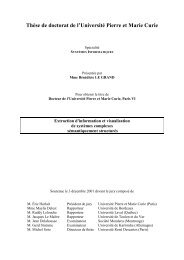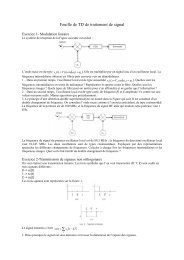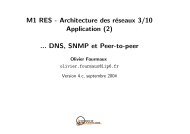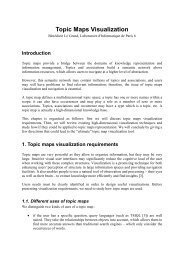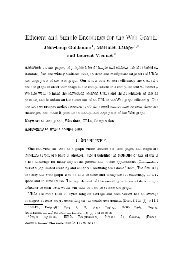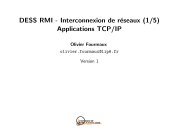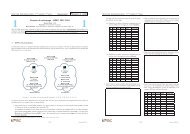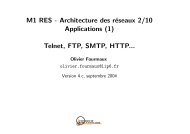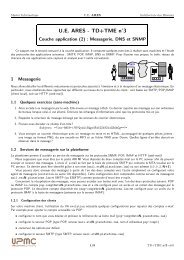U.E. Architecture des Réseaux (ARES) 3/5 : Couche transport
U.E. Architecture des Réseaux (ARES) 3/5 : Couche transport
U.E. Architecture des Réseaux (ARES) 3/5 : Couche transport
Create successful ePaper yourself
Turn your PDF publications into a flip-book with our unique Google optimized e-Paper software.
Service de base<br />
Service fiable<br />
Contrôle de congestion<br />
Principes généraux<br />
Mécanismes de TCP<br />
Service de base<br />
Service fiable<br />
Contrôle de congestion<br />
Principes généraux<br />
Mécanismes de TCP<br />
Congestion : scénario 2b<br />
Congestion : scénario 3a<br />
C/2<br />
A<br />
d_in (data)<br />
d’_in (data + retransmissions)<br />
C<br />
d_out<br />
B<br />
D<br />
d’_in<br />
C/2<br />
d_out<br />
toujours d in = d out (goodput)<br />
coût <strong>des</strong> retransmissions<br />
retransmissions utiles : seulement pour <strong>des</strong> pertes<br />
d’ in supérieur à d out<br />
retransmissions inutiles : segments en retard<br />
d’ in encore plus supérieur à d out<br />
coût de la congestion :<br />
beaucoup plus de trafic pour un d out donné<br />
dupplications de segment inutile<br />
4 émetteurs, 4 récepteurs<br />
4 routeurs<br />
chemins multi-saut<br />
tampons finis<br />
retransmission<br />
➠ Que ce passe-t-il quand d’ in augmente ?<br />
Olivier Fourmaux (olivier.fourmaux@upmc.fr)<br />
U.E. <strong>Architecture</strong> <strong>des</strong> Réseaux (<strong>ARES</strong>) 3/5 : <strong>Couche</strong> <strong>transport</strong><br />
Olivier Fourmaux (olivier.fourmaux@upmc.fr)<br />
U.E. <strong>Architecture</strong> <strong>des</strong> Réseaux (<strong>ARES</strong>) 3/5 : <strong>Couche</strong> <strong>transport</strong><br />
Service de base<br />
Service fiable<br />
Contrôle de congestion<br />
Principes généraux<br />
Mécanismes de TCP<br />
Service de base<br />
Service fiable<br />
Contrôle de congestion<br />
Principes généraux<br />
Mécanismes de TCP<br />
Congestion : scénario 3b<br />
Contrôle de congestion<br />
Deux approches :<br />
d_out C/2<br />
d’_in<br />
coût supplémentaire de la congestion :<br />
lors de la perte d’un paquet, toute la capacité amont est<br />
gachée<br />
contrôle de congestion géré par le réseau<br />
les routeurs informent les extrémités<br />
bit d’indication de la congestion (SNA, DECbit, ATM,<br />
TCP/IP ECN...)<br />
indication explicte du débit disponible (ATM ABR,<br />
TCP/IP RSVP + IntServ...)<br />
contrôle de congestion aux extrémités (end-to-end)<br />
aucune indication explicite du réseau<br />
inférence à partir <strong>des</strong> observations faites aux extrémités<br />
pertes<br />
délais<br />
approche choisie dans TCP<br />
Olivier Fourmaux (olivier.fourmaux@upmc.fr)<br />
U.E. <strong>Architecture</strong> <strong>des</strong> Réseaux (<strong>ARES</strong>) 3/5 : <strong>Couche</strong> <strong>transport</strong><br />
Olivier Fourmaux (olivier.fourmaux@upmc.fr)<br />
U.E. <strong>Architecture</strong> <strong>des</strong> Réseaux (<strong>ARES</strong>) 3/5 : <strong>Couche</strong> <strong>transport</strong>



